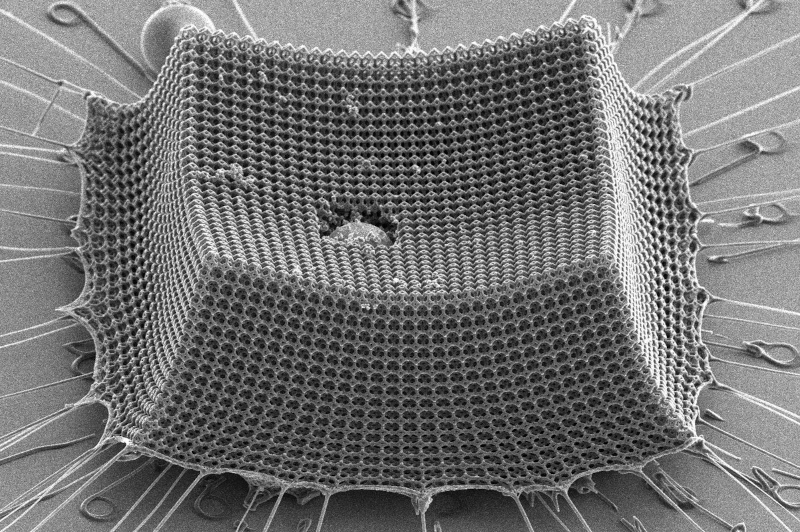Prior to 1970, bulletproof vests were pretty iffy, with a history extending as far as the 1500s when there were attempts to make metal armor that was bulletproof. By the 20th century there was ballistic nylon, but it took kevlar to produce garments with real protection against projectile impact. Now a 3D printed nanomaterial might replace kevlar.
A group of scientists have published a paper that interconnected tetrakaidecahedrons made up of carbon struts that are arranged via two-photon lithography.
We know that tetrakaidecahedrons sound like a modern invention, but, in fact, they were proposed by Lord Kelvin in the 19th century as a shape that would allow things to be packed together with minimum surface area. Sometimes known as a Kelvin cell, the shape is used to model foam, among other things.
The 3D printing, in this case, is a form of lithography using precise lasers, so you probably won’t be making any of this on your Ender 3. However, the shape might have some other uses when applied to conventional 3D printing methods.
We’ve actually had an interest in the history of kevlar. Then again, kevlar isn’t the only game in town.

















Apparently there are a lot of different 14-hedrons, and although the article provides clear enough pictures of them, I’m not certain which one these are. Maybe a truncated cube or octahedron?
“1500s when there were attempts to make metal armor that was bulletproof.” Thats wrong, there wasn’t only attempts but succesfull production of bulletproof armours in XVIth and XVIIth century high class armour was tested by shooting at it and a lot of remaining later armours has that test dent on it. You have to remember that early guns, black powder and bullets where maybe not crude – wheellock guns are amazing feats of engineering and also high points of art and craftsmanship but not highly developed so just changing shape and adding more material was enough to stop bullets.
Soft lead spherical bullets were also much easier to stop than pointed or round nosed ones made of lead alloyed with antimony. Adding a copper jacket and using smokeless powder made it rather less than possible to protect a person with any metal armor that could be light enough to wear, though some 21st century super strength steel alloys might be able to stop a .223 rifle bullet or 9mm round nose.
Agreed but i was talking about 1500s-1700s maybe early XIXth century (cuirasiers of Napoleonic times) when steel armour was still widely used on battlefield and was good enough to give its wearer chance of survival. No smokless powder then, no antimony, no jacketed bullets and no rifling.
This stuff was as least somewhat effective in the 1800s even:
https://en.wikipedia.org/wiki/Armour_of_the_Kelly_gang
Plus, of course, smooth bore guns were the norm, rifles rare, so unless you were facing a line of massed infantry your chances of getting at more than point blank range was fairly small. Shooting a charging knight with a matchlock at a safe distance, hard to do.
Searching Wikipedia for “Kelvin Cell” suggests truncated octahedra (8 hexagonal and 6 square faces) [1], [2]. Caution: material tech porn, especially [2].
[1] https://en.wikipedia.org/wiki/Weaire%E2%80%93Phelan_structure
[2] https://en.wikipedia.org/wiki/Metal_foam
Could you please stop pointing to paywalled papers?
If everyone would just ignore those, they would go away eventually.
Science should not be held hostage by people who add nothing useful to it.
It will take a lot more than random people on the internet ignoring them. Journals are engrained in our academic system because paper pushers use them as a way to ‘measure’ scientific output of a department. One university has more papers in Nature than another, for example, so it must be better. It’s stupid and it isn’t going away any time soon. The good news is most publically funded research should be available to taxpayers for free.
Kelvinlar
If it’s lighter, that’s great. As a former infantryman, Kevlar is heavy! Any reduction in weight to combat gear is always welcome. We had a saying, “Ounces equal pounds, pounds equal pain.”
Plus it would be nice if they could armour an APC so it could effectively protect the squishy contents while still being able to move at more than a crawl.